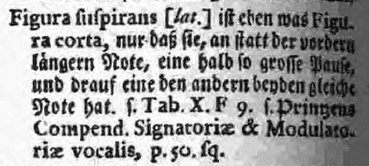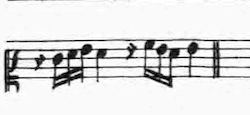In the second volume of his monumental Phrynis (Mytilenæus) Oder Satyrischer Componist (1677), Wolfgang Caspar Printz (1641–1717) gives the following definition:
“Figura Suspirans is nothing other / than a Figura Corta, which instead of the front long note / has a pause half as long and a note equal to the other two.”
“Figura suspirans ist nichts anders / als eine Figura Corta / welche an statt der fördern längern Noten eine halb so grosse Pause / und eine denen andern beyden gleiche Noten hat.”


Printz illustrates how a figura corta opening with the longer note —an eighth note— can be transformed into a figura suspirans, or simply suspirans, by replacing that eighth note with a sixteenth-note rest and a sixteenth note. Since a suspirans is a variant of a corta, it goes without saying that a suspirans also coincides with the length of one beat and therefore belongs to the decoratio, i.e. the figuration of a musical passage.
Johann Gottfried Walther (1684–1748) reproduces Printz’s definition almost verbatim:

p. 244, public domain, available on https://imslp.org.

Fig. 9, public domain, available on https://imslp.org.
Notice that Printz gives examples of the suspirans with repeated notes, stepwise motion, leaps and mixed motions, while Walther only gives examples with stepwise motion.
See also figura corta.
Select Bibliography
Butt, John. Bach Interpretation — Articulation Marks in Primary Sources of J. S. Bach (Cambridge: Cambridge University Press, 1990).
Printz, Wolfgang Caspar. Phrynis Mytilenæus Oder Ander Theil des Satyrischen Componistens — Ander Theil (Quedlinburg, 1677).
Walther, Johann Gottfried. Musicalisches Lexicon (Leipzig, 1732).
